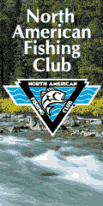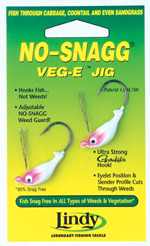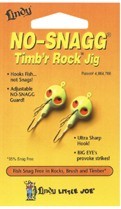













Promotional
Team Favorites
Lodging food and more








|
Fishing Snags with Veg-E-Jigs
and Floats
By Sam Anderson
Spring and early summer you can find walleyes in shallow water. Some
fish could be in 2 feet of water and others in 20 feet of water on
the
same body of water at the same time of year. All in all I have found
many walleyes that are aggressive in shallow water and I'll fish it
more
times than deep water.
In Minnesota, my home state, the movement of walleyes toward shallower
water is always constant. In early spring the walleyes are attracted
to
the aquatic life that is starting in the warm shallows. As zoo plankton
attracts small fish and minnows the walleye is attracted to these areas
to feed. In summer or early fall, during the period when days are warm
but nights are cool, bait fish begin breaking the surface in schools
just offshore, particularly during calm periods. These subtle clue
means
walleyes are biting like crazy.
By the time late summer turns into fall and the water temperature starts
to drop off; the fish start to migrate to shore. In big shallow lakes
like Mille Lacs; for example, walleyes traditionally begin leaving
the
flats and their deeper environs by this time. By mid-September they're
prowling in less than 10 feet of water much of the time.
Most fishermen would fish the obvious structural elements. The key
to
catching fish here consistently, however, is effectively identifying
spots that gather and hold most fish.
Usually when you find one up shallow, there are more nearby. They come
out to feed, and that's the only reason they are up on the bank cruising
around. These schools of big fish don't come up shallow every day,
but
if you find them, you can catch a really nice stringer.
Most of my cold-water success has come on river rock or chunk rock
banks
out towards the main river channel. Because they are on these rock
banks, I believe they are primarily looking for crawdads. Female
walleyes like to eat crawdads now as their eggs start developing for
the
coming spawn.

Lindy
No Snagg
Veg
E Jig |
Probably my favorite presentation is fishing with a jig. The No-Snagg
Veg-E-Jig from Lindy is without a doubt the best way to fish timber and
weeds. This jig allows you to penetrate the toughest brush pile on the
water without getting hung up. The front eyelet position and the slender
profile allows the Veg-E-Jig to slip through all weed vegetation and timber
without all the frustrations of snags. Like the Timb'r Rock jig it also
has the seven strand wire guard that protects the hook from snags, but
this jig has the super strong, ultra sharp Gamakatsu hook and that makes
for an awesome live bait delivery system. By dipping your
bait into various spots in the flooded timber you will find that many
walleyes are present and willing to bite |

Lindy
Timb'r Rock Jig |
Another Lindy jigging technique is to tie on a Timb'r Rock jig to the
end of the line instead of a plain hook when slip bobber fishing snags.
The Timb'r Rock jig allows you to present live bait or plastic in all kinds
of cover without fear of snags. Due to its unique "weight
centered" design, it lands upright every time. The patented seven strand
wire guard protects the hook point from hang-ups. I like the color
that a jig head adds, plus I need to add a little extra weight to pull
the
line down to the preset depth when using a jig head. If you use this
slip bobber method, it will enable you to jig your bait vertically without
positioning yourself over the top of the structure. |
With little or no wind you'll have action on the bobber. This can easily
be achieved by sweeping the rod about a foot at a time. It might seem simple,
and it is, but the results will astound you.

Thill
Center slider float |
By attaching a Thill Float to your No-Snagg approach you can get your
offering into even shallower water. This slip bobber has made a dramatic
transformation from "short and fat to long and thin". Therefore, the
Thill Float is very effective when there is a slight chop on the water.
It will allow you to drift the entire structure from one location; but
the wave action also provides some vertical movement to your bait. |
The Thill Float is part of your live bait delivery system and you will
need to make adjustments if you want your bait to be presented to the fish
in a "natural manner." To use your Thill Float properly you will first
have to determine depth. You might use your sonar to determine depth, or
attach a weight to your line and lower it into the water until your line
shows slack, but I prefer to use the old method (revised). I first put
on a Stealth Soft Stop, like the ones Lindy makes for live bait rigs. I
attach this plastic snubber ahead of my Thill Float on the
line, then I attach an additional plastic snubber to the line after
the slip bobber. Then as my weight and hook combination, I attach a Veg-E-Jig
or a or a Timb'r Rock jig. If the float lays on it's side then I readjust
the (float) bobber so that it rides off the particular structure from 1
ft. to 6 inches. If I am using Thill Float for walleyes I like to attach
a 1/16 or 1/32 ounce jig to the business end of the
line instead of a plain hook. I like the color that a jig head adds
plus I need to add very little extra weight to pull the line down to the
preset depth when using a jig head. If you use this slip float method,
it will enable you to jig your bait vertically without positioning yourself
over the top of the structure. With little or no wind you'll have action
on the bobber. This can easily be achieved by sweeping the rod about a
foot at a time. It might seem simple, and it is, but the
results will astound you.
When the walleye inhales your bait and your float slides slowly underwater,
remember to following tips: Take all the slack out of your line without
putting pressure on the fish. When you're ready to feel the fish reel as
quickly as possible putting pressure on the fish. At the same time "set
the hook", lift the rod tip towards the sky and this will penetrate the
bony roof of the walleyes mouth.
Slip bobbers may be one of the most simple yet efficient and effective
ways to present bait that there is. They can be fished at any depth, with
a variety of bait, and on most equipment.With a cane pole or a modern graphite
rod, I for one am glad to see techniques to make fishing simple and enjoyable
again. The slip (bobber) is one of these techniques that will improve your
success, give it a try.
For more information on this shallow water approach to fishing this
spring and summer drop me a line at www.samanderson.com.

Fish
Clix Banner Exchange
Walleyes Inc. website is maintained
by Randy
Tyler
Fishing the In-Fisherman Professional Walleye Circuit, Masters Walleye
Circuit and the Wal Mart RCL Circuit. All rights reserved.Copyright 1999/2003
Please visit these site sponsors
Daiichi/Tru-Turn Hooks,
Lindy
Little Joe,
R-A.M Mounting Systems,
Ranger
boats, Mercury Outboards,Bedford
Sales , Church Tackle, Panther
Marine Products,
Webfoots body sock,
Bait
Rigs Tackle ,Dual Pro Charging Systems,
Daiwa
Rods and Reels,
Driftcontrol
Wind socks,
Trojan Batteries
|




